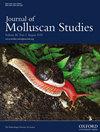鸭齿藻和画影藻对温度和藻类浓度的行为反应
IF 1.2
4区 生物学
Q2 MARINE & FRESHWATER BIOLOGY
引用次数: 0
摘要
在实验室环境下,利用延时摄影技术,我们将andonta anatina和Unio pictorum暴露在无灰分干质量为0.5至20.0 mg的普通小球藻(Chlorella vulgaris)浓度和3种不同温度(11±1、15±1和19±1℃)下4小时。我们分析了贻贝运动的比例,运动活动的持续时间,后尖端运动和阀门打开行为。在11°C时,白腹贻贝的运动比例显著高于白腹贻贝,而白腹贻贝的运动比例显著低于白腹贻贝。两种贻贝运动的比例、运动的持续时间和后尖端的运动都随着藻类浓度的增加而减少。图兰的运动时间明显较短。在这两个物种中,阀门开度在中等藻类浓度时达到峰值,与峰值的偏差在青尖藻中更为突出。最后,我们记录了两个物种的运动策略对比(a . anatina在沉积物表面爬行,而U. pictorum在沉积物中移动),并确定了行为适应的潜在密度依赖性。本文章由计算机程序翻译,如有差异,请以英文原文为准。
Behavioural responses of Anodonta anatina and Unio pictorum to temperature and algal concentration
Using time-lapse photography in a laboratory setting, we exposed Anodonta anatina and Unio pictorum for 4 h to algal (Chlorella vulgaris) concentrations ranging from 0.5 to 20.0 mg ash-free dry mass l−1 and to three different temperatures (11 ± 1, 15 ± 1 and 19 ± 1 °C). We analysed the proportion of mussels in locomotion, duration of locomotory activities, posterior tip movement and valve opening behaviour. The proportion of mussels in locomotion was significantly higher for A. anatina and for A. anatina was significantly lower at 11 °C. For both species, the proportion of mussels in locomotion, the duration of locomotion and movement of the posterior tip decreased with increasing algal concentration. The locomotory duration was significantly shorter in U. pictorum. In both species, valve opening peaked at intermediate algal concentrations, with the deviation from the peak being more prominent in A. anatina. Finally, we recorded a contrasting locomotory strategy for the two species (A. anatina crawled on the sediment surface, whereas U. pictorum moved through the sediment) and identified potential density dependence in behavioural adaptation.
求助全文
通过发布文献求助,成功后即可免费获取论文全文。
去求助
来源期刊

Journal of Molluscan Studies
生物-动物学
CiteScore
3.00
自引率
8.30%
发文量
36
审稿时长
3 months
期刊介绍:
The Journal of Molluscan Studies accepts papers on all aspects of the study of molluscs. These include systematics, molecular genetics, palaeontology, ecology, evolution, and physiology. Where the topic is in a specialized field (e.g. parasitology, neurobiology, biochemistry, molecular biology), submissions will still be accepted as long as the mollusc is the principal focus of the study, and not incidental or simply a convenient experimental animal. Papers with a focus on fisheries biology, aquaculture, and control of molluscan pests will be accepted only if they include significant advances in molluscan biology. While systematic papers are encouraged, descriptions of single new taxa will only be considered if they include some ‘added value’, for example in the form of new information on anatomy or distribution, or if they are presented in the context of a systematic revision or phylogenetic analysis of the group.
 求助内容:
求助内容: 应助结果提醒方式:
应助结果提醒方式:


